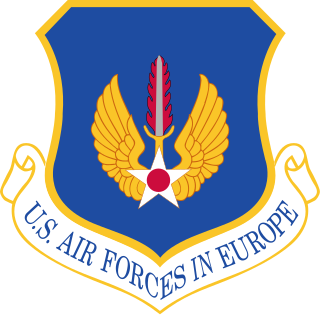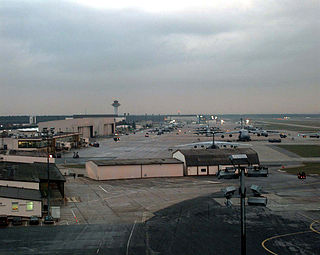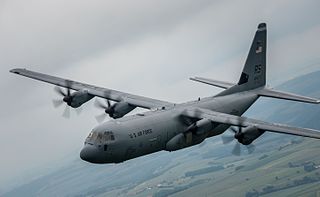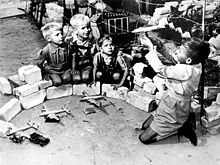
Berlin Tempelhof Airport was one of the first airports in Berlin, Germany. Situated in the south-central Berlin borough of Tempelhof-Schöneberg, the airport ceased operating in 2008 amid controversy, leaving Tegel and Schönefeld as the two main airports serving the city for another twelve years until both were replaced by Berlin Brandenburg Airport in 2020.
The history of the Royal Canadian Air Force begins in 1914, with the formation of the Canadian Aviation Corps (CAC) that was attached to the Canadian Expeditionary Force during the First World War. It consisted of one aircraft that was never called into service. In 1918, a wing of two Canadian squadrons called the Canadian Air Force (CAF) was formed in England and attached to the Royal Air Force, but it also would never see wartime service. Postwar, an air militia also known as the Canadian Air Force was formed in Canada in 1920. In 1924 the CAF was renamed the Royal Canadian Air Force (RCAF) when it was granted the royal title by King George V. The RCAF existed as an independent service until 1968.

The Douglas C-54 Skymaster is a four-engined transport aircraft used by the United States Army Air Forces in World War II and the Korean War. Like the Douglas C-47 Skytrain derived from the DC-3, the C-54 Skymaster was derived from a civilian airliner, the Douglas DC-4. Besides transport of cargo, the C-54 also carried presidents, prime ministers, and military staff. Dozens of variants of the C-54 were employed in a wide variety of non-combat roles such as air-sea rescue, scientific and military research, and missile tracking and recovery. During the Berlin Airlift it hauled coal and food supplies to West Berlin. After the Korean War it continued to be used for military and civilian uses by more than 30 countries. It was one of the first aircraft to carry the President of the United States, the first being President Franklin D. Roosevelt during World War II.

Operation Varsity was a successful airborne forces operation launched by Allied troops toward the end of World War II. Involving more than 16,000 paratroopers and several thousand aircraft, it is the largest airborne operation ever conducted on a single day and in one location.

William Henry Tunner was a general officer in the United States Air Force and its predecessor, the United States Army Air Forces. Tunner was known for his expertise in the command of large-scale military airlift operations, first in Air Transport Command (ATC) during World War II, commanding The Hump operation, and later in Military Air Transport Service (MATS) during the Berlin Airlift in 1949–1951. He eventually rose to the rank of Lieutenant general and commanded MATS itself.

Royal Air Force Gatow, or more commonly RAF Gatow, was a British Royal Air Force station in the district of Gatow in south-western Berlin, west of the Havel river, in the borough of Spandau. It was the home for the only known operational use of flying boats in central Europe, and was later used for photographic reconnaissance missions by de Havilland Canada DHC-1 Chipmunks over East Germany. Part of the former airfield is now called General Steinhoff-Kaserne, and is home to the Luftwaffenmuseum der Bundeswehr, the German Air Force Museum.

The United States Air Forces in Europe – Air Forces Africa (USAFE-AFAFRICA) is a United States Air Force (USAF) major command (MAJCOM) and a component command of both United States European Command (USEUCOM) and United States Africa Command (USAFRICOM). As part of its mission, USAFE-AFAFRICA commands U.S. Air Force units pledged to NATO, maintaining combat-ready wings based from the United Kingdom to Turkey. USAFE-AFAFRICA plans, conducts, controls, coordinates and supports air and space operations in Europe, parts of Asia and all of Africa with the exception of Egypt to achieve U.S. national and NATO objectives based on taskings by the two combatant commanders.

Rhein-Main Air Base was a United States Air Force air base near the city of Frankfurt am Main, Germany. It was a Military Airlift Command (MAC) and United States Air Forces in Europe (USAFE) installation, occupying the south side of Frankfurt Airport. Its military airport codes are discontinued. Established in 1945, Rhein-Main Air Base was the primary airlift and passenger hub for USAFE. It was billed as the "Gateway to Europe". It closed on 30 December 2005.
The history of the Royal Air Force, the air force of the United Kingdom, spans a century of British military aviation.

Colonel Gail Seymour "The Candy Bomber" Halvorsen was a senior officer and command pilot in the United States Air Force. He is best known as the "Berlin Candy Bomber" or "Uncle Wiggly Wings" and gained fame for dropping candy to German children during the Berlin Airlift from 1948 to 1949.

The Military Air Transport Service (MATS) is an inactive Department of Defense Unified Command. Activated on 1 June 1948, MATS was a consolidation of the United States Navy's Naval Air Transport Service (NATS) and the United States Air Force's Air Transport Command (ATC) into a single joint command. It was inactivated and discontinued on 8 January 1966, superseded by the Air Force's Military Airlift Command (MAC) as a separate strategic airlift command, and it returned shore-based Navy cargo aircraft to Navy control as operational support airlift (OSA) aircraft.

No. 46 Squadron of the Royal Flying Corps and the Royal Air Force, formed in 1916, was disbanded and re-formed three times before its last disbandment in 1975. It served in both World War I and World War II.

The 40th Airlift Squadron is a United States Air Force unit based at Dyess Air Force Base, Texas. It currently flies the Lockheed Martin C-130J Super Hercules aircraft. Nicknamed the Screaming Eagles, it is a decorated airlift unit in the U.S. Air Force, with several Meritorious Unit Award, six Campaign Streamers, a Service Streamer, and an Armed Forces Expeditionary Streamer.

The Berlin Airlift Squadron was a Royal Australian Air Force (RAAF) transport squadron formed to participate in the Berlin Airlift. The unit operated for one year, between August 1948 and August 1949, and was raised specifically for the operation, drawing crews from two existing RAAF transport squadrons. It flew more than 2,000 sorties during the airlift, without loss.

The 86th Operations Group is the flying operational component of the 86th Airlift Wing, United States Air Force. The group is stationed at Ramstein Air Base, Germany.

The Berlin Blockade was one of the first major international crises of the Cold War. During the multinational occupation of post–World War II Germany, the Soviet Union blocked the Western Allies' railway, road, and canal access to the sectors of Berlin under Western control. The Soviets offered to drop the blockade if the Western Allies withdrew the newly introduced Deutsche Mark from West Berlin.

On 19 June 2010, a vintage Douglas C-47 Skytrain aircraft crashed shortly after take-off from Berlin Schönefeld Airport for a sightseeing flight over Berlin, which was operated by Air Service Berlin, a provider of event flights. There were no fatalities, but seven of the 28 passengers and crew were injured.

The 332d Expeditionary Operations Group is a provisional air expeditionary group of the United States Air Force's Air Combat Command, currently active. It was deactivated on 8 May 2012 and reactivated 16 November 2014.

The 317th Operations Group is an inactive United States Air Force unit, last stationed at Pope Air Force Base, North Carolina as part of Air Mobility Command. It was activated in 1992 during the Air Force's Objective Wing reorganization, and inactivated the following year when all Air Force units at Pope were assigned to the 23d Wing.



















